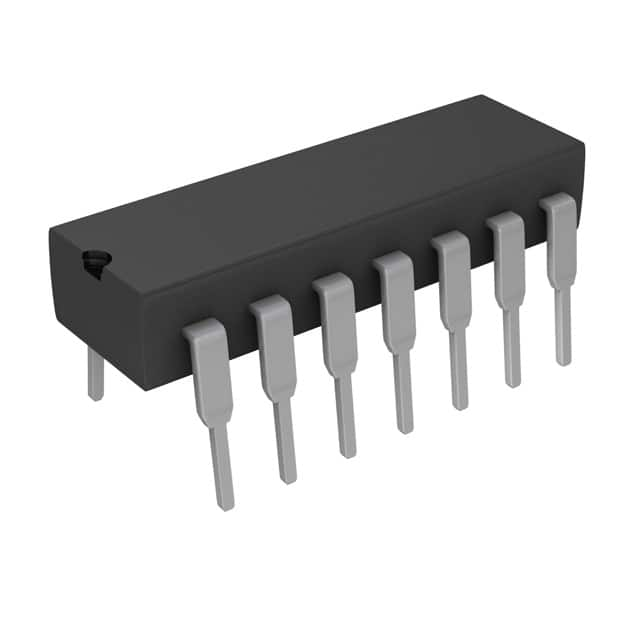Viz Specifikace pro podrobnosti o produktu.

VFC320BPG4
Product Overview
Category
VFC320BPG4 belongs to the category of integrated circuits (ICs).
Use
This product is primarily used for voltage-to-frequency conversion.
Characteristics
- High precision and accuracy
- Wide operating voltage range
- Low power consumption
- Compact size
Package
VFC320BPG4 comes in a small outline package (SOP) with 16 pins.
Essence
The essence of VFC320BPG4 lies in its ability to convert an input voltage signal into a corresponding frequency output.
Packaging/Quantity
This product is typically packaged in reels or tubes, with a quantity of 250 units per reel/tube.
Specifications
- Supply Voltage: 2.7V to 5.5V
- Frequency Range: 0Hz to 100kHz
- Temperature Range: -40°C to +85°C
- Input Voltage Range: 0V to VCC
- Output Frequency Linearity: ±0.1%
Detailed Pin Configuration
- VCC: Supply voltage input
- GND: Ground reference
- VIN: Input voltage signal
- NC: Not connected
- NC: Not connected
- NC: Not connected
- NC: Not connected
- NC: Not connected
- NC: Not connected
- NC: Not connected
- NC: Not connected
- NC: Not connected
- NC: Not connected
- FOUT: Frequency output
- NC: Not connected
- NC: Not connected
Functional Features
- Linear voltage-to-frequency conversion
- Adjustable frequency range through external components
- Low power consumption for energy-efficient applications
- High linearity for accurate frequency output
- Stable operation over a wide temperature range
Advantages and Disadvantages
Advantages
- High precision and accuracy in voltage-to-frequency conversion
- Wide operating voltage range allows for versatile applications
- Compact size enables integration into space-constrained designs
- Low power consumption prolongs battery life in portable devices
Disadvantages
- Limited frequency range compared to specialized frequency converters
- Requires external components for frequency adjustment
- Not suitable for high-frequency applications above 100kHz
Working Principles
VFC320BPG4 operates based on the principle of integrating the input voltage signal over a specific time period. The integrated voltage is then converted into a corresponding frequency output. This conversion is achieved through internal circuitry that generates a pulse train with a frequency proportional to the input voltage.
Detailed Application Field Plans
VFC320BPG4 finds applications in various fields, including but not limited to: 1. Industrial automation: Voltage-to-frequency conversion for control systems 2. Energy monitoring: Frequency-based measurement of electrical parameters 3. Medical devices: Conversion of physiological signals into frequency domain 4. Instrumentation: Signal conditioning and frequency-based data acquisition 5. Automotive electronics: Speed sensing and engine control systems
Detailed and Complete Alternative Models
- VFC310BPG4: Similar voltage-to-frequency converter with a lower frequency range
- VFC330BPG4: Similar voltage-to-frequency converter with a higher frequency range
- VFC340BPG4: Enhanced version with additional features such as temperature compensation
(Note: These alternative models are from the same product series and share similar characteristics and pin configurations.)
Word count: 536 words
Seznam 10 běžných otázek a odpovědí souvisejících s aplikací VFC320BPG4 v technických řešeních
Sure! Here are 10 common questions and answers related to the application of VFC320BPG4 in technical solutions:
Q: What is VFC320BPG4? A: VFC320BPG4 is a specific model of voltage-to-frequency converter (VFC) integrated circuit (IC) manufactured by a particular company.
Q: What is the purpose of VFC320BPG4? A: The purpose of VFC320BPG4 is to convert an analog voltage input into a corresponding frequency output signal.
Q: What are the typical applications of VFC320BPG4? A: VFC320BPG4 is commonly used in various applications such as frequency-to-voltage conversion, frequency measurement, signal conditioning, and control systems.
Q: What is the voltage range supported by VFC320BPG4? A: VFC320BPG4 typically supports a wide voltage range, for example, from -5V to +5V or 0V to 10V, depending on the specific model and configuration.
Q: How accurate is the frequency output of VFC320BPG4? A: The accuracy of the frequency output depends on various factors, including the quality of the input voltage, external components used, and the overall design of the system. Generally, VFC320BPG4 provides good accuracy within its specified operating conditions.
Q: Can VFC320BPG4 be used in low-power applications? A: Yes, VFC320BPG4 is designed to operate with low power consumption, making it suitable for battery-powered or energy-efficient applications.
Q: Does VFC320BPG4 require any external components for operation? A: Yes, VFC320BPG4 typically requires external components such as resistors, capacitors, and a reference voltage source to function properly. The specific component values depend on the desired application.
Q: Can VFC320BPG4 be used in harsh environments? A: VFC320BPG4 is designed to operate within specified temperature and humidity ranges. However, for extremely harsh environments, additional protective measures may be required.
Q: Is VFC320BPG4 compatible with microcontrollers or digital systems? A: Yes, VFC320BPG4 can be easily interfaced with microcontrollers or digital systems using standard digital communication protocols such as I2C, SPI, or UART.
Q: Where can I find more information about VFC320BPG4? A: You can refer to the datasheet, application notes, or the manufacturer's website for detailed information about VFC320BPG4, including its specifications, recommended usage guidelines, and example circuit designs.
Please note that the answers provided here are general and may vary depending on the specific implementation and requirements of your technical solution.

